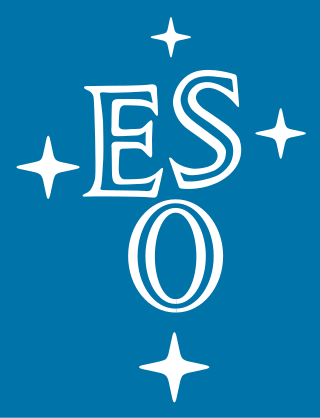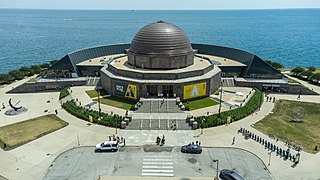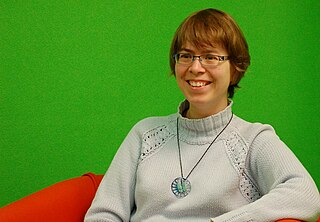Related Research Articles

An astronomer is a scientist in the field of astronomy who focuses their studies on a specific question or field outside the scope of Earth. They observe astronomical objects such as stars, planets, moons, comets and galaxies – in either observational or theoretical astronomy. Examples of topics or fields astronomers study include planetary science, solar astronomy, the origin or evolution of stars, or the formation of galaxies. A related but distinct subject is physical cosmology, which studies the Universe as a whole.

The European Organisation for Astronomical Research in the Southern Hemisphere, commonly referred to as the European Southern Observatory (ESO), is an intergovernmental research organisation made up of 16 member states for ground-based astronomy. Created in 1962, ESO has provided astronomers with state-of-the-art research facilities and access to the southern sky. The organisation employs over 750 staff members and receives annual member state contributions of approximately €162 million. Its observatories are located in northern Chile.

The Adler Planetarium is a public museum in Chicago, Illinois, dedicated to astronomy and astrophysics. It was founded in 1930 by local businessman Max Adler. Located on the northeastern tip of Northerly Island on Lake Michigan, the Adler Planetarium was the first planetarium in the United States. It is part of Chicago's Museum Campus, which includes the John G. Shedd Aquarium and The Field Museum. The Planetarium's mission is to inspire exploration and understanding of the universe.

Edwin Charles Krupp is an American astronomer, researcher, author, and popularizer of science. He is an internationally recognized expert in the field of archaeoastronomy, the study of how ancient cultures viewed the sky and how those views affected their cultures. He has taught at the college level, as a planetarium lecturer, and in various documentary films. He has been the director of the Griffith Observatory in Los Angeles since first taking over the position in 1974 after the departure of the previous director, William J. Kaufmann III. His writings include science papers and journal articles, astronomy magazine articles, books on astronomy and archaeoastronomy for adults, and books explaining sky phenomena and astronomy to children.
Rainwater Observatory and Planetarium is an educational astronomical observatory and Planetarium run as an educational ministry of French Camp Academy. It is located near French Camp, Mississippi, United States. It is the largest observatory in Mississippi with 16+ telescopes, with the largest instruments including a 32-inch Dobsonian telescope and 14-inch Celestron catadioptric telescope. Rainwater is currently awaiting delivery of the Sollee Telescope, a 25-inch research-grade telescope. When installed in the two-story observatory building already constructed in the observatory complex, the Sollee Telescope will be suitable for serious astronomical studies, in the last remaining "dark spot" in Mississippi on the U.S. Dark Skies photograph.
UNA Observatory is an astronomical observatory owned and operated by the University of North Alabama. It is located in Florence, Alabama (USA). It has 2 telescopes, a Celestron 0.35 m Schmidt–Cassegrain telescope. The UNA Planetarium is a 65-seat planetarium with a Spitz A3P projector and East Cost Control Systems controller.
Doris Daou is a Lebanese-born Canadian-American astronomer who was formerly the Director for Education and Public Outreach of the NASA Lunar Science Institute and the associate director of the NASA Solar System Exploration Research Virtual Institute (SSERVI), and is currently the program contact for NASA's "Small Innovative Missions for Planetary Exploration (SIMPLEx)".

The International Year of Astronomy (IYA2009) was a year-long celebration of astronomy that took place in 2009 to coincide with the 400th anniversary of the first recorded astronomical observations with a telescope by Galileo Galilei and the publication of Johannes Kepler's Astronomia nova in the 17th century. The Year was declared by the 62nd General Assembly of the United Nations. A global scheme, laid out by the International Astronomical Union (IAU), was also endorsed by UNESCO, the UN body responsible for educational, scientific, and cultural matters.
The Hubble Heritage Project was founded in 1998 by Keith Noll, Howard Bond, Forrest Hamilton, Anne Kinney, and Zoltan Levay at the Space Telescope Science Institute. Until its end in 2016, the Hubble Heritage Project released, on an almost monthly basis, pictures of celestial objects like planets, stars, galaxies and galaxy clusters.

Nancy Grace Roman was an American astronomer who made important contributions to stellar classification and motions. The first female executive at NASA, Roman served as NASA's first Chief of Astronomy throughout the 1960s and 1970s, establishing her as one of the "visionary founders of the US civilian space program".

The WestRock Observatory is operated by Columbus State University's Coca-Cola Space Science Center at 701 Front Avenue, Columbus, Georgia. Established in 1996, the observatory has active night sky and solar study programs for students and the general public. The equipment can be controlled and monitored remotely by faculty and astronomers. The observatory also offers mobile astronomy programs such as "Astronomy Nights" at Callaway Gardens, F. D. Roosevelt State Park, and Providence Canyon State Park as well as education outreach to the surrounding Georgia/Alabama area.

Heidi B. Hammel is a planetary astronomer who has extensively studied Neptune and Uranus. She was part of the team imaging Neptune from Voyager 2 in 1989. She led the team using the Hubble Space Telescope to view Shoemaker-Levy 9's impact with Jupiter in 1994. She has used the Hubble Space Telescope and the Keck Telescope to study Uranus and Neptune, discovering new information about dark spots, planetary storms and Uranus' rings. In 2002, she was selected as an interdisciplinary scientist for the James Webb Space Telescope.

In 2011, Chile was home to 42% of the world's astronomical infrastructure, consisting principally of telescopes. In 2015, it was estimated that Chile would contain more than 50% of the global astronomical infrastructure by 2030. In the Atacama desert region of northern Chile, the skies are exceptionally clear and dry for more than 300 days of the year. These conditions have attracted the world's scientific community to develop highly ambitious astronomical projects in the Atacama desert.

Frederick Garnett Watson AM is an English-born astronomer and popular scientist in Australia. He holds the role of Australia's First Astronomer at Large within the Commonwealth Government of Australia, relaying the important aspects of Australian astronomy to the government, the general public, and associated organisations.

The Birla Planetarium in Kolkata, West Bengal, India, is a single-storeyed circular structure designed in the typical Indian style, whose architecture is loosely styled on the Buddhist Stupa at Sanchi. Situated at Chowringhee Road adjacent to the Victoria Memorial, St. Paul's Cathedral and the Maidan in Central Kolkata, it is the largest planetarium in Asia and the second largest planetarium in the world. There are two other Birla Planetariums in India: B.M. Birla Planetarium in Chennai and the Birla Planetarium in Hyderabad.

Amanda Elaine Bauer is an American professional astronomer and science communicator. She is the Deputy Director and Head of Science and Education at Yerkes Observatory in Williams Bay, Wisconsin. She was previously based in Tucson, Arizona, working as Head of Education and Public Outreach at the Large Synoptic Survey Telescope. From 2013 to 2016 she was a Research Astronomer at the Australian Astronomical Observatory (AAO). Her principal field of research concerns how galaxies form, how they create new stars, and particularly why they suddenly stop creating new stars.

Yaël Nazé is a Belgian astrophysicist, author and professor at the University of Liège. She specializes in massive stars and their interactions with their surroundings. In her research, she has worked with images and data collected from various space telescopes and has worked on creating new observation satellites.
Carol Ann Christian is an American astronomer and science communicator, who works for the Space Telescope Science Institute as a scientist on the institute's outreach program.
Lucy Frear Fortson is an American astronomer known for her work on gamma-ray astronomy and Galaxy morphological classification and for her leadership of citizen science projects including the Galaxy Zoo and Zooniverse. She is a professor in the School of Physics and Astronomy at the University of Minnesota.

Nandivada Rathnasree or N. Rathnasree was an Indian astrophysicist, science communicator, and science historian, who was the director of India's Nehru Planetarium for over twenty years. She was responsible for improvements to the planetarium, as well as for researching the use of historical architectural astronomical instruments in India. She is known for her work in science communication.
References
- 1 2 3 Macleod, Rod (16 March 2017). "Kenya's Susan Murabana explores the stars". BBC News . Retrieved 29 October 2023.
- 1 2 3 4 5 Machira, Sharon (18 September 2023). "'I want to see the first African woman in space': the Kenyan stargazer bringing astronomy to the people". The Guardian . Retrieved 29 October 2023.
- 1 2 3 Carlson, Erika K. (30 October 2020). "The First Planetarium Under Kenyan Skies". Physics . 13 (169) – via American Physical Society.
- 1 2 3 "Kenyan astronomer puts stars in girls' eyes". Scrolla. 20 September 2023. Retrieved 29 October 2023.
- 1 2 3 Fitch, Chris (20 August 2022). "How Kenya's stargazing safaris offer fresh perspectives for wildlife watching". National Geographic . Retrieved 29 October 2023.
- 1 2 3 4 5 "2023 Mentor: Susan Murabana Owen". United Nations Office for Outer Space Affairs . 2023. Retrieved 29 October 2023.
- 1 2 3 Scott, David Clark (15 November 2021). "Lessons in awe and wonder from Kenya's Travelling Telescope". The Christian Science Monitor . Retrieved 29 October 2023.
- 1 2 Maringa, Felix (28 October 2023). "Traveling telescope helps Kenyans reach for the stars". Deutsche Welle . Retrieved 29 October 2023.
- 1 2 3 Clark, Kevin L. (4 November 2020). "Meet Susan Murabana: The Architect of the First Planetarium in Africa". Essence . Retrieved 29 October 2023.